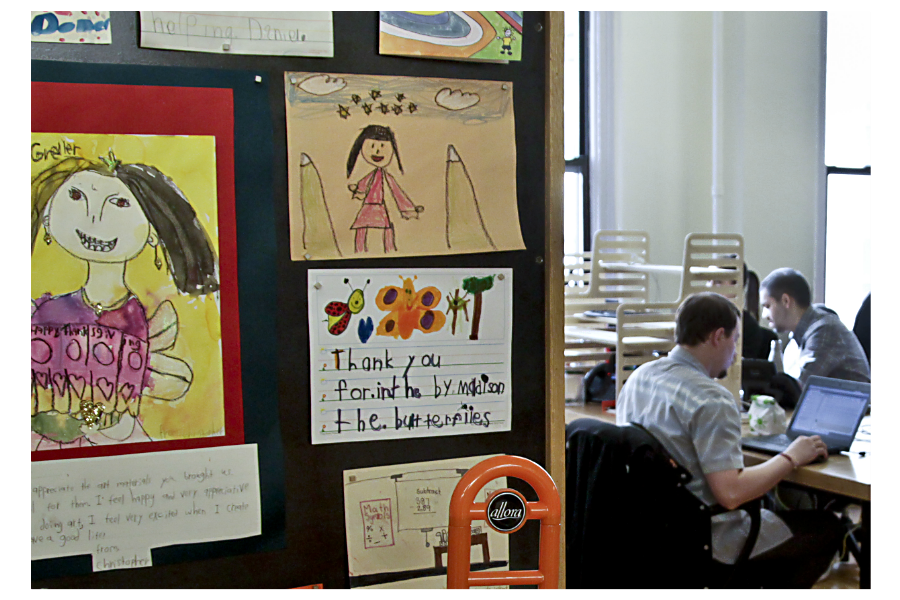Teachers crowdfund school supplies. A success, but should it be necessary?
Loading...
Alexandria Boyd needed books. As a schoolteacher at Little Rock Preparatory Academy, a public charter school that caters to underserved communities in Arkansas, she struggled to provide her students with reading material appropriate for their grade level.
In January 2015, Ms. Boyd turned to DonorsChoose.org, a crowdfunding website that helps public school teachers raise funds for projects and classroom materials. She put together a book list for her students – who ranged from pre-K to grade 2 – and posted an online appeal: help her reach a target amount of $556, enough for 123 books.
“I want to expand my students’ literacy and reading skills. I would like to expose them to more read [alouds] and help increase their vocabulary skills,” Boyd wrote on the project page. “Because our library is so small, we do not have many grade level books. We need help.”
In the face of continued tight budgets within school districts across the US, a growing number of educators nationwide have turned to online philanthropy as a means of funding classroom needs. Over the years, sites such as DonorsChoose.org and AdoptAClassroom.org have helped teachers like Boyd – who spend on average about $500 of their own money every year on classroom supplies – raise millions of dollars for books, supplies, and programs.
The approach is no substitute for policy solutions to public education’s financial issues, some education experts say. Still, data suggest that crowdfunding and online philanthropy have proved valuable resources to teachers. What’s more, the strategy has underscored the Internet’s role in transforming the way educators address the challenges of providing students with quality education on a budget.
“Teachers and schools and students have been doing bake sales and car washes since probably the beginning of public education,” says Chris Pearsall, senior director of communication and events at DonorsChoose.org, based in New York. But the Internet has “opened up philanthropy to everyone, democratized it. … [This approach] has potential for teachers to help relieve their burden and unleash their creativity.”
The numbers indicate a substantial impact. Since its inception in 1998, Minneapolis-based AdoptAClassroom.org has raised about $28 million in donations and provided funding and supplies for more than 143,000 classrooms in school districts across the country, according to the company’s annual report. PledgeCents, a fundraising platform in Houston, Texas that caters to pre-K to 12 teachers, boasts on its website that it has raised nearly $450,000 and served more than 200,000 students in 47 states.
And since 2000, DonorsChoose.org has collected more than $400 million in donations for more than 700,000 projects in 67,000 schools.
On Thursday, the group announced an initiative that involved 58 celebrity philanthropists – including actor Samuel L. Jackson, tennis star Serena Williams, and Facebook executive Sheryl Sandberg – coming together to fulfill teachers’ wish lists on the website. In all, the volunteers pledged more than $14 million to fund close to 12,000 classroom projects across the country.
“We had people from all walks of life: Musicians, actors, athletes, business owners,” Mr. Pearsall says. “It was incredible.”
Yet despite the visible impact of such efforts, some technology ethicists warn that relying on too much on crowdfunding – especially for education and classroom needs – could have major drawbacks.
“I view it as a band-aid,” says David Polgar, co-founder of the Digital Citizenship Summit, a global network of projects that aim to promote safe and ethical use of social media and technology. Making online philanthropy a model for raising funds long-term could not only lead to audiences burned out from giving out of the goodness of their hearts, he says. It could also let the people responsible for addressing the real issues off the hook.
“We want to make sure that schools don’t view crowdfunding as alleviating their duty to fund necessary equipment,” Mr. Polgar says. “It would be nice if we could switch the focus to saying, ‘We should properly fund supplies in classrooms,’ instead of shaking the proverbial can and saying, ‘Hey everyone, put money in.’
“Let’s solve the problem instead of giving a free pass to schools,” he says.
Still, even Polgar acknowledges how online philanthropy does give teachers and communities a platform to voice their concerns and act on the problems they face.
“It's moved the conversation about classroom management outside of those four walls,” he says. “You're allowing parents and students to have more of a say, and participatory citizenship is certainly something beneficial.”
Boyd, the teacher from Arkansas, might echo that sentiment. In April – about three months after she first posted her appeal – donors to the site helped her reach her target amount. With the money, she wrote, she planned to buy books that featured such figures as Abraham Lincoln, Frida Kahlo, and Michael Jordan. She hoped to broaden her students’ knowledge of American history and Hispanic and African American cultures.
Months later, Boyd returned to the site, thanking the people who donated to her cause.
“The impact that this donation made in my classroom, school, and community is difficult to explain with words,” she wrote. “My students love their classroom books. They have told their parents about it and parents have said their children are asking to read more at home.
“Thank you so much for giving to my students and letting them know that their education is important.”








